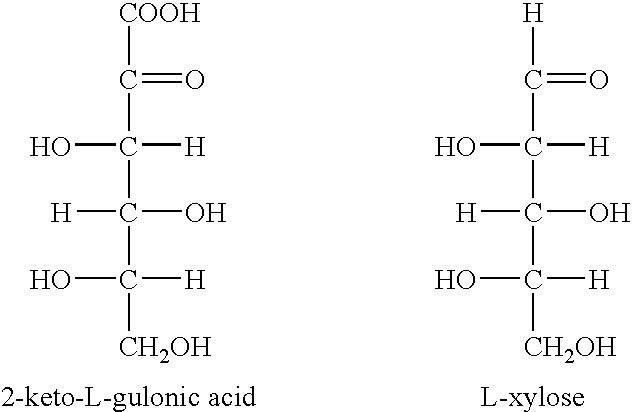Enzymatic decarboxylation of 2-keto-L-gulonic acid to produce xylose
- Summary
- Abstract
- Description
- Claims
- Application Information
AI Technical Summary
Benefits of technology
Problems solved by technology
Method used
Image
Examples
example 1
[0122] Cloning of the pdc gene from Zymobacter palmae. The pdc gene was cloned, sequenced, and expressed in E. coli (Raj et al., Appl. Environ. Microbiol. 2002, 68:2869-2876). Genomic DNA was prepared from Zymobacter palmae based on a method described by Harwood and Cutting (Molecular Biology Methods for Bacillus, Wiley Interscience, NY, 1990). PCR of the genomic DNA from Zymobacter palmae (ATCC 51623) resulted in the amplification and isolation of the DNA fragment that contains the open reading frame of the PDC enzyme. The primers were synthesized based on the sequence published in Raj et al., (Appl Environ. Microbiol. 2002, 68:2869-2876) with GenBank accession number AF474145. The PCR products containing the open reading frame of PDC was ligated into a vector plasmid, pTrc99 (Pharmacia Biotech Products, Piscataway, N.J.). The plasmid was transformed into E. Coli strain DH5a (Life Technologies, Rockville, Md.). The transformed E. coli was grown in Luria-Bertani (LB) medium and the ...
example 2
[0123] Decarboxylation of 2-KLG by PDC. A sample of E. coli PDC enzyme extract was provided. The E. coli overexpressed PDC enzyme derived from Z. palmae. PDC enzyme activity was determined by the method described by Raj et al. (Raj et al., Appl. Environ. Microbiol. 2002, 68:2869-2876).
[0124] Initial decarboxylation of 2-KLG was carried out using the enzyme extract. The reaction mixtures contained PDC derived from Z. palmae in a 50 mM citrate buffer, at pH 5.8, with 5 mM MgCl2 (Sigma Biochemicals and Reagents, St. Louis, Mo.), 1 mM thiamine pyrophosphate (TPP) (Sigma Biochemicals and Reagents, St. Louis, Mo.) and 0.1% to 1% 2-KLG. The reaction mixtures were incubated at 50° C. for 15 hours. Xylose was produced in a dose dependent fashion ranging from 10 to 100 μg / ml. Xylose production directly correlated to the concentration of PDC used.
Example 3
[0125] Another experiment was performed using optimum conditions to confirm the production of xylose. The reaction mixtures contained 50 ...
example 3
[0126] PCR mutagenesis of PDC open reading frame to improve its activity on 2-KLG. 2-KLG is not the natural substrate for PDC. The novel enzymatic reaction of the invention, 2-KLG decarboxylation by PDC, can be improved by further genetic engineering of the enzyme. DNA recombinant methods can be employed to modify the enzyme to have higher activity with 2-KLG.
[0127] In particular, the GeneMorph PCR Mutagenesis kit (#60050, Stratagene, La Jolla, Calif.) was used to generate mutuations with a PCR method. The plasmid of Example 1 was used as a template with the same primers for the mutagenesis PCR reactions. The PCR products were cloned into the plasmid pTrc99 (Pharmacia). Twenty clones were characterized for PDC activity and for their ability to decarboxylate 2-KLG. Compared to the control strain, which had no mutations, most of the 20 strains had less specific activity on native substrate, pyruvate, as well as on 2-KLG. This indicated that the mutations occurred in parts of the enzy...
PUM
| Property | Measurement | Unit |
|---|---|---|
| Nanoscale particle size | aaaaa | aaaaa |
| Mass | aaaaa | aaaaa |
| Mass | aaaaa | aaaaa |
Abstract
Description
Claims
Application Information
 Login to View More
Login to View More - R&D
- Intellectual Property
- Life Sciences
- Materials
- Tech Scout
- Unparalleled Data Quality
- Higher Quality Content
- 60% Fewer Hallucinations
Browse by: Latest US Patents, China's latest patents, Technical Efficacy Thesaurus, Application Domain, Technology Topic, Popular Technical Reports.
© 2025 PatSnap. All rights reserved.Legal|Privacy policy|Modern Slavery Act Transparency Statement|Sitemap|About US| Contact US: help@patsnap.com



